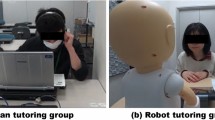Abstract
To help second language (L2) learners acquire oral communication skills, dialogue-based computer-assisted language learning (DB-CALL) systems are attracting more interest than ever. When robot-assisted language learning (RALL) is used for realizing such systems, L2 learners are provided with a sense of reality and tension similar to that in a real L2 conversation. At the same time, there are increasing demands for remote learning, accelerated in part by the spread of the novel coronavirus. We have therefore developed a robot-avatar-assisted language learning system that simulates a trialogue in English with two robot avatars and a learner for remote learning. The conversation scenarios deal with various daily topics to keep the learner’s interest and the system prompts the learner to acquire oral skills by using specific syntactic forms in conversation. We conducted a six-day remote learning experiment with ten Japanese university students to evaluate the learning effect, using eye gaze as an index of the learners’ degree of concentration. Our findings demonstrated the effectiveness of our system for remote learning and showed that the learners’ eye gaze activities changed between question answering and repeating tasks.
Access this chapter
Tax calculation will be finalised at checkout
Purchases are for personal use only
Similar content being viewed by others
References
Bloom, B, S.: The 2 sigma problem: the search for methods of group instruction as effective as one-to-one tutoring. Educ. Res. 13(6), 4–16 (1984)
Truscott, J.: What’s wrong with oral grammar correction. Can. Mod. Lang. Rev. 55, 437–456 (1999)
Long, M.H.: The role of the linguistic environment in second language acquisition. In: Handbook of Second Language Acquisition, pp. 413–468 (1996)
Swain, M.: Communicative competence: some roles of comprehensible input and comprehensible output in its development. In: Input in Second Language Acquisition, pp. 235–253 (1985)
Swain, M.: The output hypothesis: theory and research. In: Handbook of Research in Second Language Learning, pp. 471–483 (2005)
DeKeyser, R.M.: Practice in a Second Language: Perspective from Applied Linguistics And Cognitive Psychology. Cambridge University Press, Cambridge (2007)
Warschauer, M.: Computing face-to-face and electronic discussion in the second language classroom. CALICO J. 13(2), 7–26 (1996)
Chang, S., Lee, J., Chao, P., Wang, C., Chen, G.: Exploring the possibility of using humanoid robots as instructional tools for teaching a second language in primary school. Educ. Technol. Soc. 13(2), 13–24 (2010)
Hegelheimer, V., Chapelle, C.A.: Methodological issues in research on learner-computer interaction in CALL. Lang. Learn. Technol. 4(1), 41–59 (2000)
Hjalmarsson, A., Wik, P., Brusk, J.: Dealing with DEAL: A dialogue system for conversation training. In: Proceedings of the 8th SIGdial Workshop on Discourse and Dialogue, pp. 132–135 (2007)
Lee, K., Kweon, S., Lee, S., Noh, H., Lee, G. G.: POSTECH immersive English study (POMY): dialog-based language learning game. IEICE Trans. Inf. Syst. E97-D(7), 1830–1841 (2014)
Vries, B.P., Cucchiarini, C., Bodnar, S., Strik, H., Hout, R.: Spoken grammar practice and feedback in an ASR-based CALL system. Comput. Assist. Lang. Learn. 28(6), 550–576 (2015)
Bibauw, S., Francois, T., Desmet, P.: Discussing with a computer to practice a foreign language: research synthesis and conceptual framework of dialogue-based CALL. Comput. Assist. Lang. Learn. 32(8), 827–877 (2019)
Randall, N.: A survey of robot-assisted language learning (RALL). ACM Trans. Hum. Robot Interact. 9(1), 7:1–35 (2019)
Khalifa, A., Kato, T., Yamamoto, S.: Joining-in-type humanoid robot assisted language learning system. In: Proceedings of the Language Resources and Evaluation Conference(LREC 2016), pp. 245–249 (2016)
Wainer, J., Feil-Seifer, D., Mataric, M.,: Embodiment and human-robot interaction: a task-based perspective. In: The 16th IEEE International Symposium on Robot and Human Interactive Communication, pp. 872–877 (2007)
Chang, C., Lee, J., Wang, C., Chen, G.: Improving the authentic learning experience by integrating robots into the mixed-reality environment. Comput. Educ. 55, 1572–1578 (2010)
Acknowledgement
This work was supported by JSPS KAKENHI Grant Number 19K00927.
Author information
Authors and Affiliations
Corresponding author
Editor information
Editors and Affiliations
Rights and permissions
Copyright information
© 2021 Springer Nature Switzerland AG
About this paper
Cite this paper
Najima, T., Kato, T., Tamura, A., Yamamoto, S. (2021). Remote Learning of Speaking in Syntactic Forms with Robot-Avatar-Assisted Language Learning System. In: Ekštein, K., Pártl, F., Konopík, M. (eds) Text, Speech, and Dialogue. TSD 2021. Lecture Notes in Computer Science(), vol 12848. Springer, Cham. https://doi.org/10.1007/978-3-030-83527-9_48
Download citation
DOI: https://doi.org/10.1007/978-3-030-83527-9_48
Published:
Publisher Name: Springer, Cham
Print ISBN: 978-3-030-83526-2
Online ISBN: 978-3-030-83527-9
eBook Packages: Computer ScienceComputer Science (R0)




